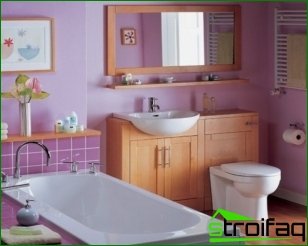The best option for wall decoration in the bathroom is tile. But if such material is not yet affordable, then you can choose the most economical way, namely to paint the walls. If you choose a more expensive paint, the walls will look beautiful, but, and the addition of color will give all the possibilities to create any color.
But in order to achieve the greatest effect, it is necessary to carefully prepare the walls, acquire a high-quality tool, but also, of course, show your creative abilities. As you know, the bathroom is characterized by high humidity, so the paint must be chosen not only moisture resistant, but with antibacterial protection, so as not to create all conditions for the comfortable reproduction of unpleasant fungi. In addition, it is better to apply paint to those parts of the walls that are not exposed to water, but for the walls near the washbasin and the bathroom it is still better to use tiles, or, in extreme cases, glass panels.
What paint to choose
So, for rooms such as a bathroom, the following types of paint are chosen. This is a water-based paint, which in turn is divided into silicone, acrylic, latex and with the addition of PVA. Chloraucukova, it is usually used for finishing pools, as it does not allow moisture to pass through. You can choose oil paint, but it dries for a long time and it has a rather unpleasant odor. Therefore, it is best to opt for a water emulsion, but here’s which one to choose, try to find out.
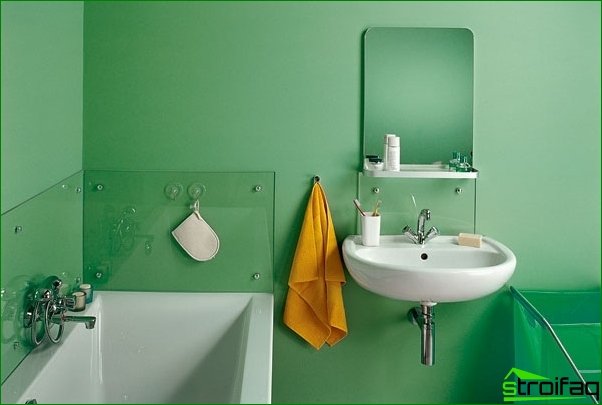
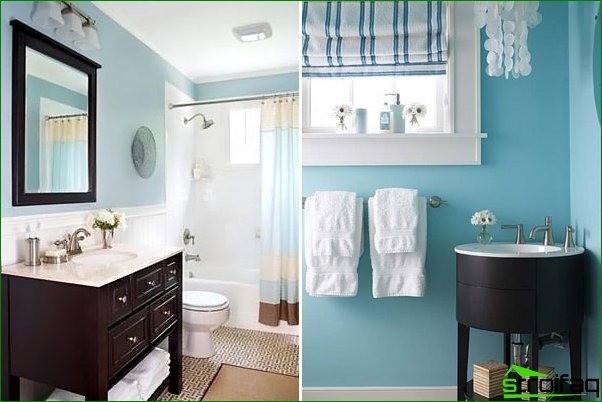
The most popular water based acrylic emulsion. It is available at its cost, perfectly applied to the surface and is suitable for wet rooms. After applying latex paint, a film appears on the surface, which protects it from moisture and dust. Paint based on PVA is one of the budget finishing materials and is not suitable for the bathroom, it can be used to finish ceilings in other rooms. The most modern material is silicone paint, which is not afraid of the effects of water and has a vapor-tight structure.
So, for a bathroom, a latex and acrylic based water emulsion is best suited.
It is also important not only to decide what exactly to apply on the walls, but also to choose a color. In any specialized store, a tinting apparatus is provided that can create any shade, but knowing the necessary proportions, the desired shade can be achieved manually.
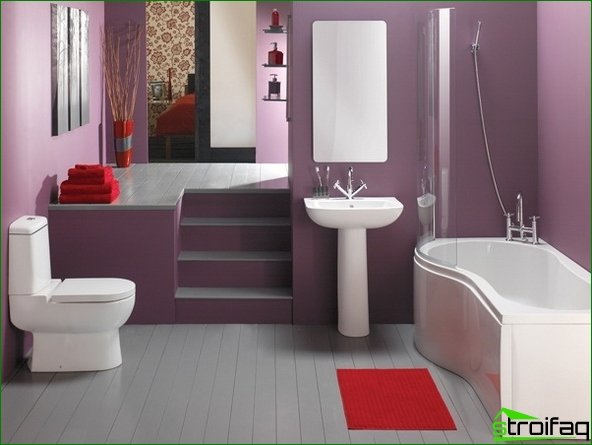
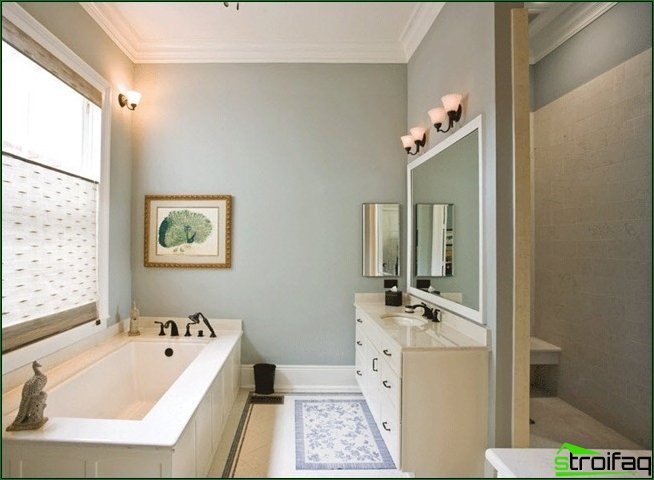
Many designers advise using light colors to paint the walls of a small bathtub, which will visually enlarge the room. But for large bathrooms, you can choose a more contrasting color. It is also worth considering that on dark colors water streaks are too noticeable.
Glossy or matte
A glossy surface always looks aesthetically pleasing and with a special gloss, but it is better to use such a paint if the walls have a perfectly smooth surface.
Matte paint can hide defects, fits harmoniously into any interior, but is poorly resistant to mechanical stress. You can also choose embossed paint, which forms a fine structure and thereby removes small roughness.
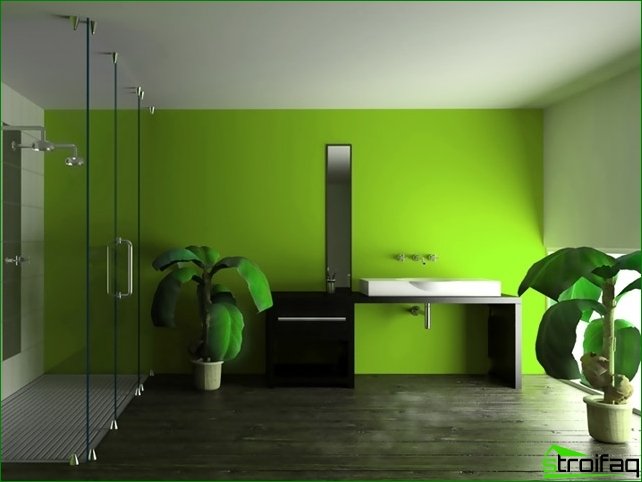
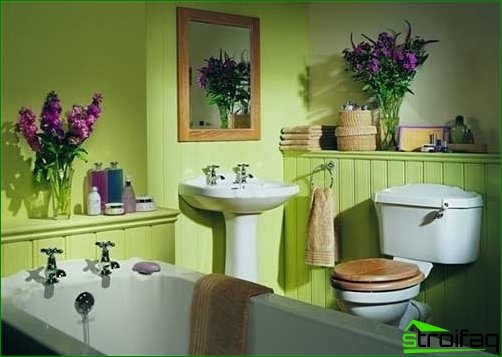
Preparation for painting
Before you start painting the walls, you need to prepare them, otherwise, the walls will not look aesthetically pleasing. Preliminary work with the base is that you need to remove the old coating, rid the walls of dust, for this they need to be washed with water and primed. If there are flaws, they can be covered with waterproof acrylic putty and sanded all the bulges with sandpaper. For priming, it is better to choose latex primers with an antibacterial coating.
The best option for wall decoration in the bathroom is tile. But if such material is not yet affordable, then you can choose the most economical way, namely to paint the walls. If you choose a more expensive paint, the walls will look beautiful, but, and the addition of color will give all the possibilities to create any color.
But in order to achieve the greatest effect, it is necessary to carefully prepare the walls, acquire a high-quality tool, but also, of course, show your creative abilities. As you know, the bathroom is characterized by high humidity, so the paint must be chosen not only moisture resistant, but with antibacterial protection, so as not to create all conditions for the comfortable reproduction of unpleasant fungi. In addition, it is better to apply paint to those parts of the walls that are not exposed to water, but for the walls near the washbasin and the bathroom it is still better to use tiles, or, in extreme cases, glass panels.
What paint to choose
So, for rooms such as a bathroom, the following types of paint are chosen. This is a water-based paint, which in turn is divided into silicone, acrylic, latex and with the addition of PVA. Chloraucukova, it is usually used for finishing pools, as it does not allow moisture to pass through. You can choose oil paint, but it dries for a long time and it has a rather unpleasant odor. Therefore, it is best to opt for a water emulsion, but here’s which one to choose, try to find out.


The most popular water based acrylic emulsion. It is available at its cost, perfectly applied to the surface and is suitable for wet rooms. After applying latex paint, a film appears on the surface, which protects it from moisture and dust. Paint based on PVA is one of the budget finishing materials and is not suitable for the bathroom, it can be used to finish ceilings in other rooms. The most modern material is silicone paint, which is not afraid of the effects of water and has a vapor-tight structure.
So, for a bathroom, a latex and acrylic based water emulsion is best suited.
It is also important not only to decide what exactly to apply on the walls, but also to choose a color. In any specialized store, a tinting apparatus is provided that can create any shade, but knowing the necessary proportions, the desired shade can be achieved manually.


Many designers advise using light colors to paint the walls of a small bathtub, which will visually enlarge the room. But for large bathrooms, you can choose a more contrasting color. It is also worth considering that on dark colors water streaks are too noticeable.
Glossy or matte
A glossy surface always looks aesthetically pleasing and with a special gloss, but it is better to use such a paint if the walls have a perfectly smooth surface.
Matte paint can hide defects, fits harmoniously into any interior, but is poorly resistant to mechanical stress. You can also choose embossed paint, which forms a fine structure and thereby removes small roughness.


Preparation for painting
Before you start painting the walls, you need to prepare them, otherwise, the walls will not look aesthetically pleasing. Preliminary work with the base is that you need to remove the old coating, rid the walls of dust, for this they need to be washed with water and primed. If there are flaws, they can be covered with waterproof acrylic putty and sanded all the bulges with sandpaper. For priming, it is better to choose latex primers with an antibacterial coating.
To paint the walls, you can use tools such as a brush, roller or spray gun. The brush increases paint consumption, but tightly envelops the surface. Using a roller, you can apply a thinner layer, but it is not so easy to paint small irregularities and corners. The spray gun is able to apply paint evenly and efficiently, but such a tool requires careful care. Of course, if the bath is small, it is better to buy a brush and a roller, and not spend money on the purchase of equipment.
The main nuances of painting
As a rule, a water emulsion is applied to the walls in two layers. To remove excess paint from the roller or brush, it is better to use a special tray with grooves. It is recommended to stick masking tape on the borders of adjacent walls that do not need to be painted. It is better to start painting with hard-to-reach spots and corners, and then go to the rest of the surface.
After complete drying of the first layer, you can immediately apply the second. If you decide to make the walls not monotonous, but with the addition of squares, lines and other shapes, it is also worth using masking tape or a special stencil.
